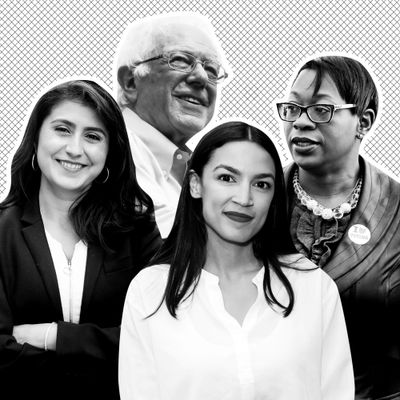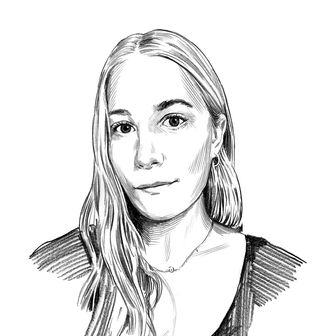
People were hanging onto fences and standing on the Queensboro Bridge to get a glimpse of the Bernie Sanders rally on Saturday, which drew a total of nearly 26,000 people — thousands more than the park could fit. It had the air of a party, but not exactly celebratory, yet — the atmosphere was more charged, as attendees anticipated a big moment. When “Back in Black” by AC/DC eventually played on the loudspeakers, to signal Sanders’s time to speak, the crowd went nuts, doing air drums and screaming for the senator from Vermont, who wore a gray sweater and carried a manila envelope.
The song choice, as well as the event’s tagline — #BerniesBack — functioned as a nod to the 78-year-old’s recovery from a heart attack on October 2 that seemed to throw his campaign’s viability into question. But the event was much more than a Sanders comeback. After four years of debate over the makeup of his base, which has been characterized as white and male thanks to a phalanx of obnoxious online supporters known as “Bernie Bros,” the rally solidified a wildly different image of the coalition behind Sanders in 2020. The senator was flanked by a set of young, progressive politicians that don’t look anything like the man of the hour — that’s if you even believe there was a man of the hour, and not a woman: Alexandria Ocasio-Cortez, the 30-year-old Latina congresswoman from the Bronx. Attendees were cheering as much for Sanders as for Ocasio-Cortez, who introduced the candidate, and whose endorsement has signaled that the grassroots movement behind Sanders comprised in large part by working-class women of color is his biggest asset.
Before Sanders addressed the audience, Ocasio-Cortez characterized him as the man who had introduced her, with his own presidential run in 2016, to movement politics. She went even further back, connecting his health care, housing, and social justice agendas in Congress to her own life: “When I was a baby, my family relied on Planned Parenthood for prenatal care. Then, Bernie Sanders fought for me,” she said. “When the federal government decided to discriminate and abandon my queer family and friends, Bernie Sanders was putting his career on the line for us.” “Preach, Alex!” someone yelled.
It was an effort to recast Sanders’s ideology as a democratic socialist through the lens of Ocasio-Cortez’s identity as the child of working-class Puerto Ricans — likely because the two concepts are routinely pitted against each other. Ocasio-Cortez’s endorsement of Sanders, along with Representative Ilhan Omar and, presumably, Representative Rashida Tlaib, “broke certain people’s brains,” in the words of a friend, because some pundits have fixated on Sanders struggle to appeal to voters of color, and to women, since he is neither.
Sanders has admitted to rethinking his campaign’s approach to both race and gender since 2016. While supporters like Ocasio-Cortez offer counter-evidence to the Bernie Bro phenomenon, they also resist being framed solely by superficial discussions of who they are. “As a woman of color, why back an old white guy?” Ocasio-Cortez was asked at the rally by a CBS correspondent. The implication was that, as a woman, she would be more likely to endorse a female candidate like Elizabeth Warren, who is also running a progressive campaign. Instead, Oscasio-Cortez answered the question in terms of how Sanders serves her interests as a Latina, as a woman, and as a working person. “I’m actually very excited about this partnership,” she replied, “because it shows what we have to do in this country. We have to come together across race, across gender, across generations.”
Ocasio-Cortez was introduced by Tiffany Cabán, the queer Latina public defender who nearly upset the Queens district attorney race. Before Cabán, Sanders was endorsed by a host of New York politicians of color, including State Senators Jessica Ramos and Julia Salazar, part of the wave of challengers whose victories helped win Democratic control back in the state legislature in 2018. Before that, there was San Juan Mayor Carmen Yulín Cruz, and former Ohio State Senator Nina Turner, both Sanders campaign co-chairs. They were all there to support Sanders’s candidacy, but their presence signaled that the battle he is nominally leading is also being waged far beyond him. Seeing these women one after the other was a glimpse of the future they were all organizing for. “This is not just about electing a president,” said Winnie Wong, a senior Sanders campaign adviser. “This is about building a long term social movement to actually make sure that we elect 100 state senators like Jessica Ramos. That we have 100 more congresswomen like AOC. That’s the political revolution.”
The women who spoke before Sanders emphasized that he had laid groundwork for grassroots, ground-up change that they would be carrying on long after his candidacy — a version of his “Not me, us” campaign slogan. Supporters in the crowd felt the same. “Bernie’s for working people, and that’s what I like,” said Carla, a 17-year-old Latina from southern Queens whose parents are both airline employees. She will turn 18 days before New York’s primary election, and intends to cast her first-ever electoral ballot for Sanders. When asked about whether she had qualms over voting for an old white guy, she rolled her eyes. “Like, my father’s an old white guy!” she said. “He’s okay! We welcome anyone into the movement, anyone who is on our side.”


